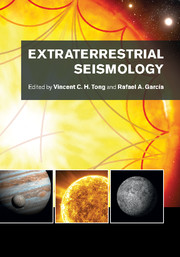Book contents
- Frontmatter
- Contents
- List of contributors
- Preface
- Acknowledgements
- List of abbreviations
- Planetary seismology: High risk, high return
- A bright outlook for helio- and asteroseismology
- Part I Observation and space missions
- 1 Asteroseismology observations and space missions
- 2 Helioseismology: Observations and space missions
- 3 Planetary seismometry
- Part II Data and physical parameters
- Part III Modeling approaches
- Part IV Discoveries of physical structures and processes
- Part V Interdisciplinary research involving planetary and astrophysical sciences
- Part VI Interdisciplinary research involving terrestrial seismology
- References
- Index
1 - Asteroseismology observations and space missions
from Part I - Observation and space missions
Published online by Cambridge University Press: 05 July 2015
- Frontmatter
- Contents
- List of contributors
- Preface
- Acknowledgements
- List of abbreviations
- Planetary seismology: High risk, high return
- A bright outlook for helio- and asteroseismology
- Part I Observation and space missions
- 1 Asteroseismology observations and space missions
- 2 Helioseismology: Observations and space missions
- 3 Planetary seismometry
- Part II Data and physical parameters
- Part III Modeling approaches
- Part IV Discoveries of physical structures and processes
- Part V Interdisciplinary research involving planetary and astrophysical sciences
- Part VI Interdisciplinary research involving terrestrial seismology
- References
- Index
Summary
Introduction
Variable stars have been observed since the discovery of the variability of Mira by David Fabricius at the end of the sixteenth century (Olbers, 1850) with a variation of 10 stellar magnitudes! The first known photometric measurement gf variability was done by Goodracke (1783) for Algol, comparing with stars differing by two magnitudes only. Using the same technique, Goodricke and Englefield (1785) discovered that δ Cephei was a variable star showang a periodical non-sinusoidal variation of about one magnitude.
Roberts (1889) suggested the use of photography for studying variable stars. The technique for detecting variable stars was quickly improved by photographically recording variations in the stellar spectra (Fleming, 1895), which would lead to visual identification of these variables (Reed, 1893).
The use of the selenium photometer by Stebbins and Brown (1907) and the development of the photoelectric cell, as anticipated by Stebbins (1915), introduced the electric determination of variability of stars (Stebbins, 1911). This was the start of an era: the detection of photons using the photoelectric effect. Improvement in the instrumentation led to lower detectable levels of variability that led to the discovery of rapidly oscillating Ap stars by Kurtz (1978). These stars oscillate with periodicity of about 6 to 10 minutes with an amplitude of about a t`ousandth of a magnitude (mmag). Kurtz and Shibahashi (1986) were even able to reach a noise limat of about 0.02 mmag on HR3831 Kurtz and Martinez, 2000).
From space, lower levels of variabilities had already been detected on the Sun using the ACRIM (Actave Cavity Radiometer Irradiance Monitor) instrument aboard the Solar Maximum Mission (Woodard and Hudson, 1983); the noise level was about one part per million (ppm, close to one μ mag). From the ground, clear detection of solar-like oscillations (pressure modes or p modes) in intensity and with spatial resolution was made possible using a property of the atmosphere combined with the significant angular diameter of the Sun (Appourchaux et al., 1995) (see also Chapter 2 of this book).
- Type
- Chapter
- Information
- Extraterrestrial Seismology , pp. 11 - 24Publisher: Cambridge University PressPrint publication year: 2015



